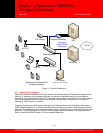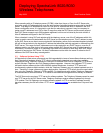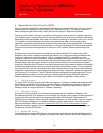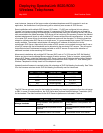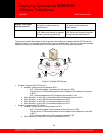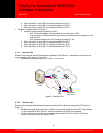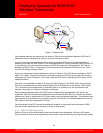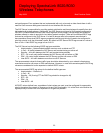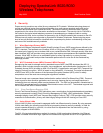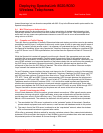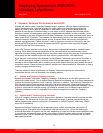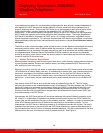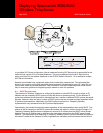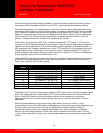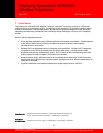
Deploying SpectraLink 8020/8030
Wireless Telephones
May 2009 Best Practices Guide
6 Subnets, Network Performance and DHCP
Subnets are used to create a boundary between network segments. Although these boundaries are
logical, they become like a physical boundary for mobile network devices moving throughout the
enterprise. When a device with an established IP data stream (such as with an active phone call)
attempts to roam across a subnet boundary, it must obtain a valid IP address within the new subnet.
During this process, the data stream cannot be re-established automatically and the connection (voice
call) is dropped. In the case of SpectraLink Wireless Telephones, the handsets should be power cycled to
obtain a new DHCP IP address. The handsets can automatically recover in the new subnet from a lost
network connection with the original subnet, but the 40-second failure and recovery time generally
warrants cycling the power. Please note that in order for the phone to continue functioning in the new
subnet the DHCP scope must contain the appropriate DHCP options to allow the phone to regain
connectivity with the voice infrastructure.
Some APs, Ethernet switches and third-party devices have implemented methods to facilitate subnet
roaming. While these methods are transparent to the client device and are fundamentally a good
approach to accommodating multiple subnets, they often cause enough delay and jitter to manifest poor
voice quality and the tradeoffs might make such solutions unattractive for voice applications.
Since the push-to-talk feature of the SpectraLink i640 Wireless Telephones use multicast IP packets, a
PTT call will generally be isolated to a single subnet. With the deployment of IP multicast routing it is
possible for the multicast traffic that is normally pruned at the network boundary to be passed into one or
more other subnets. Please review your network manufacturer’s documentation for information on how to
properly configure multicast routing.
There are additional subnet requirements for Wireless Telephones based on the infrastructure
components that are used, as described in the following sections.
6.1 Subnets and Telephony Gateway Interfaces
SpectraLink Wireless Telephones, Telephony Gateways, SVP Server(s) and the APs generally must
reside on the same subnet. This is required because SpectraLink handsets use IP multicast messages to
initialize the handset registration on the Telephony Gateways. In addition, The Telephony Gateways and
SVP Server(s) use multicast to discover each other and stay synchronized. Most routers deployed in
multi-subnet Ethernet environments are configured to filter out multicast and broadcast messages. Unless
a router is configured for multicast routing, if a handset is powered up on a different subnet than the
Telephony Gateway to which it is registered, the multicast message will not reach the Telephony
Gateway.
6.2 Subnets and IP Telephony Server Interfaces
With an IP telephony interface, the SVP Server can be placed on a separate subnet from either the APs
or call server. The handsets will find the SVP Server and call server on another subnet through the
default gateway option statically configured in the handset or via DHCP option 3 when using a DHCP
server for IP addressing.
SpectraLink Wireless Telephones can be deployed across multiple subnets when used with an IP
telephony server if the performance requirements outlined below are met. One of two deployment
scenarios described in this section can be used, depending on needs and infrastructure capabilities. Keep
in mind that the handsets will never actively roam across a subnet boundary without power-cycling the
handsets unless a VIEW Certified layer-3 roaming infrastructure is used in accordance with the VIEW
deployment guidelines.
27
©2009 Polycom, Inc. All rights reserved.
Polycom and the Polycom logo are registered trademarks of Polycom, Inc. All other trademarks are the property of Polycom, Inc. or their respective companies.



